Episode #359: How To Prepare For The Upcoming Standardized Math Test & Reduce Your Unwanted Pressure
LISTEN NOW HERE…
WATCH NOW…
As standardized math testing season approaches, many teachers feel the pressure of covering content while ensuring students are prepared. Whether it’s state assessments or EQAO in Ontario, the added stress can lead to a scramble to fit everything in.
In this episode, we explore effective strategies to maximize learning time without resorting to last-minute cramming. From elementary to secondary classrooms, we share approaches that help students feel confident and capable—without overwhelming them.
Key Takeaways:
- How to make the most of limited instructional time leading up to standardized tests.
- Productive ways to reinforce key concepts without resorting to ineffective drill-and-kill methods.
- Practical strategies for both elementary and secondary classrooms.
- How to balance content review with maintaining student engagement and confidence.
- Shifting the focus from cramming to meaningful learning experiences.
Attention District Math Leaders:
Not sure what matters most when designing math improvement plans? Take this assessment and get a free customized report: https://makemathmoments.com/grow/
Ready to design your math improvement plan with guidance, support and using structure? Learn how to follow our 4 stage process. https://growyourmathprogram.com
Looking to supplement your curriculum with problem based lessons and units? Make Math Moments Problem Based Lessons & Units
Be Our Next Podcast Guest!
Join as an Interview Guest or on a Mentoring Moment Call
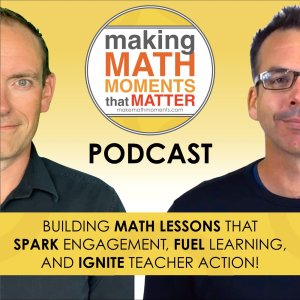
Apply to be a Featured Interview Guest
Book a Mentoring Moment Coaching Call
Are You an Official Math Moment Maker?
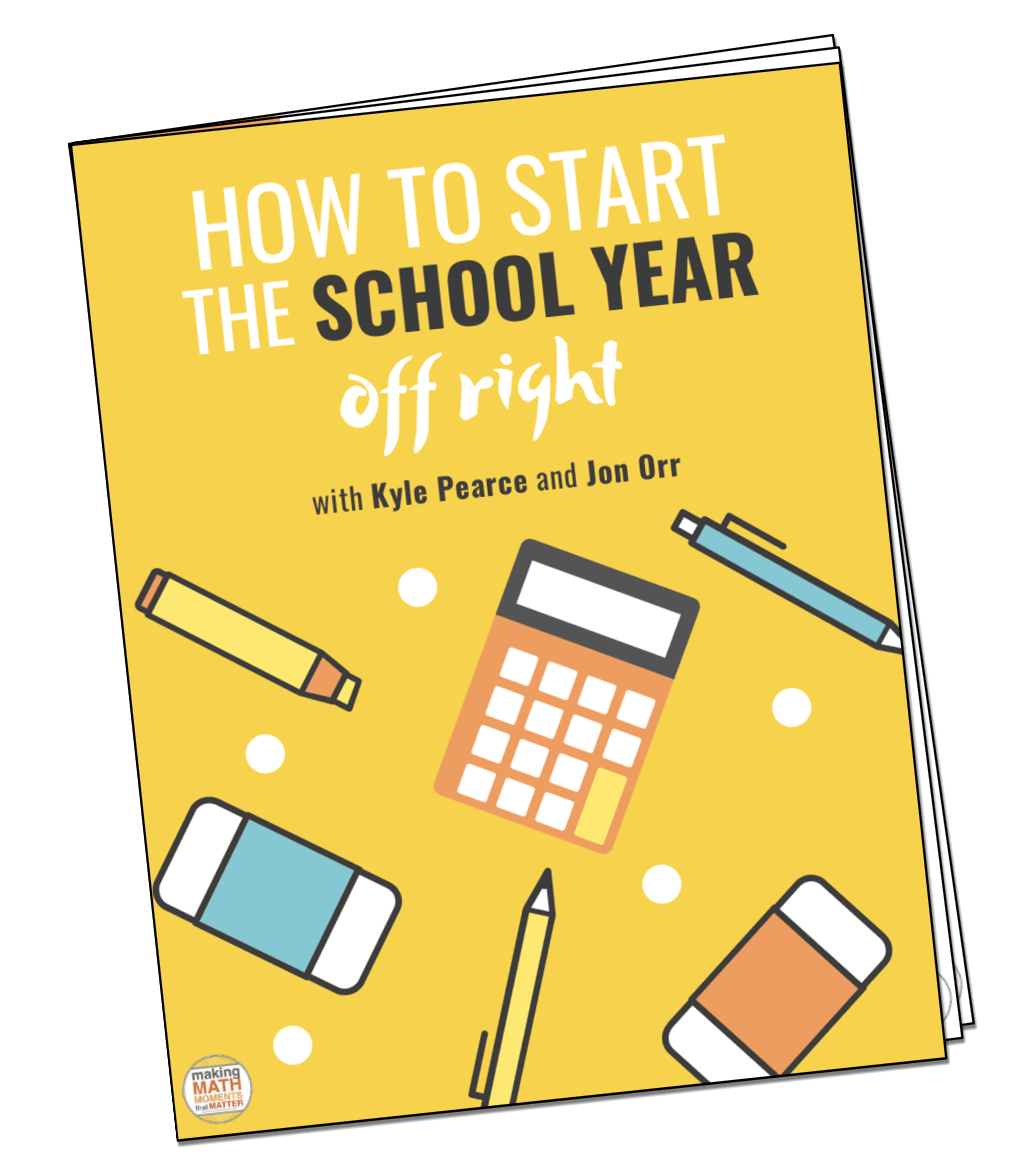
FULL TRANSCRIPT
Kyle Pearce: Are you feeling the pressure of standardized math testing season? In this episode, we’re going to explore strategies to maximize time, reduce stress, and prepare students without overwhelm ING them or you. Tune in now for practical tips for both elementary and secondary teachers. Let’s do this.
Yvette Lehman: Welcome to the Making Math Moments That Matter podcast. I’m Kyle Pierce.
Kyle Pearce: And I’m John, or we are from Ignite moments.com.
Yvette Lehman: This is the only podcast that coaches you through a six step plan to grow your mathematics program, whether it’s at the classroom level or at the district level.
Kyle Pearce: And we do that by helping you cultivate and foster your mathematics program like strong, healthy and balanced. So if you master the six parts of an effective mathematics program, the impact that you’re going to have on your teachers, your students will grow and reach far and wide.
Yvette Lehman: Every week, you’ll get the insight you need to stop feeling overwhelmed, gain back your confidence, and get back to enjoying the planning and facilitating of your mathematics program for the students or the educators that you serve. All right, math moment makers, we are going to be digging into, topic, an idea that may be on your mind right now.
Now, if you’re listening well into the future, you know, maybe the timing might not be ideal, but when this episode goes live, we are now entering into standardized tests, which, I’m telling you right now, it seems like this is the shift when we’re chatting with district leaders, when we’re chatting with educators, we sort of move throughout the school year.
At the beginning of the school year, it’s all about new ideas. It’s all about, you know, improving pedagogical practices. How do we reach our students in different ways? How do we do content knowledge better? And then we get to this time of the year, and all of a sudden it’s like nothing else matters. You know, all of a sudden we’re shifting to, we’ve got to get ready for the big test.
And I’ll be honest, I remember very vividly the pressure for, teaching grade nine here in Ontario. We have a standardized test, and there was a lot of pressure, at least perceived, you know, in my own mind here. So we’re going to dig in today. Friends, like, what can we do here when we’ve got this pressure, this stress, maybe this anxiety around standardized testing?
And how can we still maintain the big ideas, the goals, the objectives that we really set for our mathematics classroom? And how do we sort of merge these two things so that ideally, the standardized test should actually show improvement? If the things we’re doing throughout the year is actually helping our students better understand and comprehend mathematics.
Jon Orr: I was just talking to a teacher yesterday who here in Ontario is a grade three teacher. So in elementary we do standardized tests in grade three and six. And you know, like many teachers at this time, his pressure right now was I have so much content left to cover and not enough days like I’m the ceiling of I’m running out of time and I didn’t get to all of these units.
And you know, he had them all mapped out in front of him. And he’s like, look, there’s just not enough time to get to all of this learning. And I think that that pressure is real. I taught grade six predominantly in the classroom. I pretty much always taught in a standardized testing grade. And I know this feeling. And so I wanted our conversation today to be just some really like, practical strategies to help teachers alleviate some of this pressure and also maximize them. Leverage the time that they have in front of students leading up to their their testing period.
Kyle Pearce: Yeah, let’s do it. And let’s break it into two parts, like let’s let’s talk in elementary. Let’s talk secondary. And I being both, you know, secondary teachers before we became math coaches and math coordinators, you know, you beat being in the grade six classroom. Fill us in like let’s let’s start elementary wise. Like what? Knowing that this is the time period where we’re coming into the end of the year, we know that this is happening.
You know, what are we doing to use that time up, effectively, but also make sure that we’re, I guess, trying to in this situation like that teacher could cover as much as we can, but also keep true to the roots of of what you’re trying to achieve in your math classroom.
Jon Orr: Okay, so my suggestion might sound very counterintuitive to some of you. Yes. So leading into typically our testing starts, you know, April, May that month leading into the assessment. And they are assessed in most math and language. We would make a shift toward, you know, a pretty heavy math and language focus in our classroom. So we we kind of quiet down the noise of some of the other content area.
So, you know, we’re spending less time in science, less time in social space. And that’s the advantage, right, of having a generalist teacher is that you do have your students for 250 minutes a day. So there’s a lot of instructional time in the day. So we did give ourselves permission to shift some of the time around, knowing that once the testing was over, we could really focus in on the other subject areas.
But one thing that worked really well for me, and there’s actually brain science to back this up, is that if I was going to have a heavy content day, I actually integrated a lot of outdoor time and movement, and this was my thinking. It’s like I needed 30 minutes of very, very focused learning time where engagement was really high.
So if that meant going outside for ten 15 minutes and getting our heart rates up and getting movement in our bodies, and then coming back and being in a in a space where we could focus for 30 minutes. That worked really well for the 12 year olds in front of me. It’s like I needed them not to be exhausted, laying on their desks, completely burnt out and disengaged.
So maybe again, counterintuitively, I spent more time doing physical activity and outdoor learning during that time when I was really trying to solidify big ideas and concepts in the curriculum.
Yvette Lehman: This is really interesting, and I think a lot of people right now are going like, oh, they they might have just got more anxious, event when you said that because they’re like, wait a second, I don’t have enough time. And yet you’re saying, let’s get outside. Now, you had mentioned, though, you were in a situation where you’re with the same group of students all day.
You can, you know, flexibility with the scheduling in terms of what you’re going to do when you’re going to do it. But it makes me also wonder, too, as we move forward and we think beyond this time, which will pass. I want to remind everyone this time does eventually pass, and you go back to the drawing board next year and you know, you get back on the wagon.
The question or the wonder I have is like, how do we do more of that from the start of the year? Because the worry that I think we need to be aware of, or we need to recognize, is the fact that there’s so much that we cover and I’m using my little bunny ears here throughout the school year that actually isn’t getting covered for students.
Meaning, you know, we did it, we did that. And it’s it’s not being retained. It’s not being, you know, students aren’t aren’t feeling fluent, flexible with the strategies and what they’re learning. So the reality is, is that when we get to this crunch time, I think you are more, I would say, you know, likely to do the exact opposite of what you just said.
You’re just going to naturally try to grind through it all. And as a result, you’re probably going to get the opposite effect like you did it. You can check it off, but your students haven’t really gotten any further ahead. So I love the idea of really reframing in terms of like, how do I get really effective teaching time?
And then I want to extend what you’ve said, and I want to apply it. It doesn’t matter if it’s elementary or secondary, but if you’re doing some of that, what it will force you to do is to start thinking about what really matters. There is a lot of content, and I understand it. You’re supposed to quote unquote, cover it all, but it really forces you to go, okay, if I’m looking at this big long list of standards and I’m feeling like I’m not going to be able to do justice to all of these things, the real question becomes is what is really important?
What’s going to have the greatest impact on student achievement for this standardized test and what may not? Now, it doesn’t necessarily mean completely skipping over something, but it really forces you to start doing some deep thinking, some some standard soul searching to really figure out. Like when I take a minute of time in my class to, you know, my minute ten minute block, 30 minute block, doesn’t matter what the timing is when I commit to learning or to a specific activity that I’m going to be doing with my students, what sort of impact and influence is that going to have on the overall outcome?
And what should I be sort of committing certain, blocks of time to and what might I commit less to? It’s not about just chunking it all up and, you know, sort of, using the equality approach, I’m going to call it the math equity approach. Right. Your standard equity approach, what is what requires the most amount of time, the most attention, and what might not require as much time where you might be able to commit less to and that might be able to, you know, allow you the opportunity to do some of what that saying where you can go, listen, if I can keep more students paying attention longer, engaged longer, I’m going to have an overall better outcome anyway. So we’ve got kind of a little bit of a compound idea here for you to consider, but I’m curious. John, where’s your head at here? Well, I Challenge.
Kyle Pearce: What you said is a is an is an important point because I think it bleeds into, you know, some of the successes we had at the secondary level, thinking about this in terms of, in terms of what are the big ideas like, what are the pillars of our math class? Like, what are we trying to do here all year long?
Because that’s an important question to answer. And it’s and it kind of guides the work that you do all year long and how you structure things. And what are you focusing on during the year so that when you do get to the end of the year, it doesn’t feel like there’s a pressure. So, for example, and I think, I think this is where we may miss the boat if, if in terms of what we’re trying to do, like with experience, as long as we are active, taking active reflection on the work we’re doing with our students every single year, then you will get better.
Like you’re going to get better. And when if you actually reflect about this time. So if you’re feeling the crunch, if you feeling like this teacher right now is like, I have so much to cover that I’ve, I’ve either pushed or we we spent more time here, but we didn’t spend time here. And now I’ve, I’ve, I’ve got so many missed strands or so many missed topics and I can’t cover it in that time period.
Then this is a good time to also go like what will I do next year so that I’m not in this position or I’ve lessened this feeling I have about where I am because that’s the learning we do. This is how our profession is. You know, we get we get better every year. We do this and every year we we reflect.
But if we not reflecting on what we’ve done this year to to create this scenario or mitigate the scenario for next year, then then you’re not going to get any better and it won’t, and you’ll be in the same situation. And we don’t want that. Like you need to kind of think about that component. So so when I think about what we’ve done, you know, in the secondary level is that when I had those those pressures, we said, what shifts are we going to make?
Like what are those pillars of math that we really want to highlight? What is it about math class that we really want to make sure our students next year know, so that by the time standardized testing comes around, it doesn’t feel like, you know, we’re under the gun. So have we created, you know, and shared the, the, the big ideas around what we’re trying to do is like focusing on problem solving is was a major component for us, focusing on community and building trust inside the classroom and culture.
It was a major thing for us. Teaching through problem solving for curiosity purposes was a major focus that we put. And when we did that, and we started to teach through problem solving where we gave students problems that they did not expect, we gave students problems they had never solved before and never seen before. And we work together through solving them and give them time, grappling, experience, coaching through that process.
When we did that regularly, then by the end of the year, it didn’t feel like it was all of a sudden like this, this major thing that all of a sudden kids are going to get new problems that they’ve never seen before on a standardized test. And and now they got to struggle through that, like we’ve been doing it all year long, giving students different scenarios, different problems, problems that look like test problems that didn’t look like test problems.
And all of a sudden it was like we built and we weren’t teaching to the test. But what we were doing was building resiliency, building this, this problem solving approach through the year so that when that test showed up, it was like you’ve always seen, like these unfamiliar problems and you spend longer time on doing each problem because that’s just the way we did it.
And and I think, you know, that’s just what we did. And I think it’ll be different for everybody. But the important point here is if you’re uncomfortable right now, what are you prepared to change so that you’re a little bit better next year and you’re a little bit more comfortable going into this scenario next year? I still got another point, but I’m going to stop here unless you guys, you guys kind of jump in and share your thoughts on on some of the ideas we discussed.
Jon Orr: You’re just talking about, you know, shifts in practice that are good practice for the whole year. And I’m wondering if it’s not too late to make some of these shifts right now. So if it’s, you know, you have a month, you have six weeks. One of the ones that stood out to me is typically the way that we do summative assessments is we teach a unit on fractions, and then we assess expectations around fractions.
And they’re very isolated and directly connected through what was just explicitly taught. But could we get into the practice of routinely having mixed cumulative assessment so that I can take the fraction assessment, the summative assessment from the unit in my textbook? But I can add questions from other strands that were previously taught throughout the year, so that students are constantly working on the skill of retrieval.
So they’re not always just answering questions very focused on the topic we’re currently covering. They are in routinely having to jump between strands and different expectations, and that’s just a norm for them. So that’s a practice you could implement tomorrow. I love a quiz. This Friday, add four questions from a previous topic or a previous strand.
Yvette Lehman: Or and to extend that idea, what about what about adding a few questions from a future strand or a future, set of standards? Right. And, you know, John, you and I had the habit of doing this. It was almost like building in diagnostic like opportunities. The students didn’t realize, like, we didn’t say, hey, this is a diagnostic test, or, hey, this is a cumulative test or a summative test.
We just give questions. And we had students work on these problems, and we provided feedback on them. And you know what I’m picturing right now because a lot of people are going, okay, I love John’s idea of like how I might restructure this next year. But like Yvette saying is like, I could starting tomorrow, give students a couple of questions and I say a couple like, we’re not talking like a full diagnostic test or anything like that, just to see where students are, because, I mean, that’s great teaching practice anyway.
But you’re in a place now where you almost have to write if you’re feeling like I’ve got this much to do, like a huge amount of content, and I only have like half the amount of time that I would like, what you really want to do is you need to figure out sooner than later where students already feeling okay, like where they at a place where you’re like, oh, like, that’s a good launch point for me.
And then you can spend more time focusing in on the things that really matter instead of, let’s say, running. The lesson that I’ve ran the last ten times I did this course when maybe only three of the kids in the class really will benefit from that lesson anyway, right? So really taking this time to try to gather as much insight about the content that you haven’t had an opportunity to explore, to see what are students bringing with them right.
And we’re not talking about them becoming experts out, knowing the algorithms or anything like that, but just like knowing what they bring to the table is a huge, huge help so that you can use that as a jumping off point instead of spending time. And I’m going to call it wasting time on potentially ideas that we don’t really need to spend any time on with this group.
Kyle Pearce: And, and that’s I think you both of you hit on with that second point I wanted to make was that when we made shifts around embedding, you know, retrieval into the regular work that we were doing, you know, when we when we built in Kyle, we’ve talked about this here in the podcast many times over the years. You know, we call them growth days, assessment days.
But what we did was really what we were doing is, was building in spiraled moments where we were allowing students to go back in and work on different, different standards that we knew that they were, say, not as proficient on as as they needed to be. And they knew that we got to communicate that to them and they could go, hey, I’m working on that today, and I’m in work on that tomorrow.
And and I’ve got a new standard coming up that is new to me, but I know that I’ll have a chance to go back and reflect on that sooner or later on and get reassessed on it, or work towards showing my growth on those standards, like when we made the pivot towards growth around standards and students demonstrating what they know and understand and do on those standards, then.
And you could do it now, like you’re saying you might, you could start that now. It became but when we did that all year, then this whole like crunch time didn’t seem like a problem because we had been, say, review it in a way, I’m going to use air quotes here reviewing. But really what we were doing was just demonstrating or giving multiple opportunities to demonstrate an understanding around the standards that were there all year long.
And when we did that, it was it was built in, you know, prepping and reviewing, getting ready for, say, whatever, whatever assessment. It came our way. It was it was already there. So it did. Students didn’t feel like, hey, I haven’t seen this since September, and now it’s April and even though because we’ve always had access to it and were working on it since then, we built that into our kind of our schedule.
And, even though we thought initially that we were it would take up time. We actually gained so much time back because we didn’t have to spend so much time reviewing or giving extra time specifically on one standard. We can assess like we can give more time on all the standards and let students choose what standard based off, you know, what they have done in the past.
So that was a game changer for us, and especially at this time of year, it changed our mindset around what we were going into in terms of standardized testing time.
Jon Orr: So we’re going to summarize some of our maybe strategies or suggestions for people who are finding themselves in this situation. So the one that Kyle identified is like, you really know what to prioritize. I take a deep look at the expectations or standards that are left to cover and determine, you know, where are the ones that hold a lot of weight that are going to be really critical for student understanding at this, at this point in their learning trajectory, which ones need more time?
Which ones need less? We also talked about incorporating the habit of mixed practice and mixed assessments just as a best practice. So we’re not only going to teach fractions, practice fractions, and assess fractions. We’re going to constantly build in that retrieval, that recall of previous learning into our practice and into our assessments. One other thing I don’t know if we, you know, intentionally mentioned or explicitly mentioned this, John, but just the idea that and you said this to Kyle about I can give students a question on a topic I haven’t taught yet. And students should be comfortable being exposed to novel problems.
Kyle Pearce: Yeah. I’m going to put a caveat that because only because someone might listening right now and go like and I know that our listeners know what we’re talking about. But if they share this with with another person who’s like their they have a, say, a different mindset around what we just said is that because someone might say, well, you can’t you can’t grade them without teacher saying them, but but like, that’s not what we’re talking about, right?
We’re not talking about we’re using it as a you said this word Kyle diagnostic. Right. So if it shows up on my assessment or my test, then I have to have taught them. But not if you’re using it for a like true assessment for, purposes, which means like we’re going to use that information to help steer our instruction in our next steps. Like that’s what we’re talking about.
Yvette Lehman: Well and so side bar done. Well. Yeah. But I want to add this though John. Here’s the crazy part. Like imagine you know a student does that. And they do well on that. Right. Can use that as assessment and as an evaluation of basically what they know. What I don’t want to do is I don’t want to use it against them.
Right. So I don’t want to use that information against them, summative Lee or anything like that. But again, this is all about data. It’s all about understanding your students. It’s all about understanding like where do we want to go? What do we need to do? Because every group is different and it’s going to look different, which makes it hard.
Like this is hard work. I could plan what I think is a perfect, perfect year in terms of pacing, and I get a group of students and that pace is completely wrong for them. You know, it’s not going to work because they know a bunch of things that maybe the last group didn’t bring with them, and vice versa.
Some of the things the last group didn’t struggle on, this group is struggling on. And the reality is it’s all about gathering the data so that we can do whatever we can to position students to get the learning and the opportunities that they need. So the last piece of the summary here, I’m going to share, just so we can kind of put a nice little rubber stamp on it, but incorporating movement, whether it’s outdoor learning, whether it’s getting up and getting students to like take a one minute break and walk around to someone and ask them a prompt, almost like an icebreaker.
But guess what? It’s not an icebreaker, but ask them an interesting question to get them going and get them thinking about something different, and then back to their seats, or back to a different group of seats, or whatever it might be that you need to give students the break, the mental break that they need. Because I’m telling you this much, when I am sitting and, you know, sitting and getting at a conference and, you know, in a workshop, doing something all day long, boy oh boy, how helpful it could be to just get up, reframe your thinking a little bit, get them distracted from what it was we were just chatting about, so that
when we do come back, they’re feeling fresh. They’re feeling ready to go. Whether it’s a minute, ten minutes, whatever amount you need get, get those students moving and make sure that, you know, we’re giving them an opportunity to kind of reframe their thinking a little bit.
Kyle Pearce: Awesome. So there’s a summary of a few, a few of our say recommendation. Now by all means, these are not the only things that you want to consider. And I’m sure what you’re doing, you know, could be could be working just fine. So just some nuggets to kind of noodle on. But you know, the things that we talked about here specifically are, are things that we’ve done over the course of our careers and, and really just try to strengthen, you know, your classroom tree and to think about this, this moment where you’re coming into the end of the year and going, like, what?
What should I be doing to go into this time period? What could I be doing to prevent some of the feelings I’ve had? But when we think overall, some of the recommendations are all touch on those six components of effective classrooms and effective mathematics classrooms. You know, we talked about specifically kind of the, the, the, the trunk of the tree, which is kind of like the pillars of our math class, like the goals and what we’re trying to do in math class, we talked about, you know, different teaching moves.
So they are the branches of our tree, to, to put into place. We talked about kind of assessment which is, is part of say say those limbs of the tree but also those branches of the tree. So these all of these things are strengthening those six components of the tree. And if we keep thinking about how to strengthen each of the six components every single year, we’re going to get a little bit better every year.
And then eventually this time of year doesn’t, you know, we don’t feel the same pressure. We don’t feel the same anxiety going into the to the end of the year. And that’s and that’s important component, you know, to make sure that we feel feel good about what we’re doing. If you’re unsure about all six components of, your effective mathematics classrooms, head on over to make math moments.com/grow make math moments.com/grow learn about those components there.
Also you can take a quick assessment that will help you in pinpoint you know which area or which of the six areas you want to kind of pinpoint or focus on. Next. Thanks, everybody. We’ll see you soon.
Thanks For Listening
- Book a Math Mentoring Moment
- Apply to be a Featured Interview Guest
- Leave a note in the comment section below.
- Share this show on Twitter, or Facebook.
To help out the show:
- Leave an honest review on iTunes. Your ratings and reviews really help and we read each one.
- Subscribe on iTunes, Google Play, and Spotify.
DOWNLOAD THE 3 ACT MATH TASK TIP SHEET SO THEY RUN WITHOUT A HITCH!
Download the 2-page printable 3 Act Math Tip Sheet to ensure that you have the best start to your journey using 3 Act math Tasks to spark curiosity and fuel sense making in your math classroom!
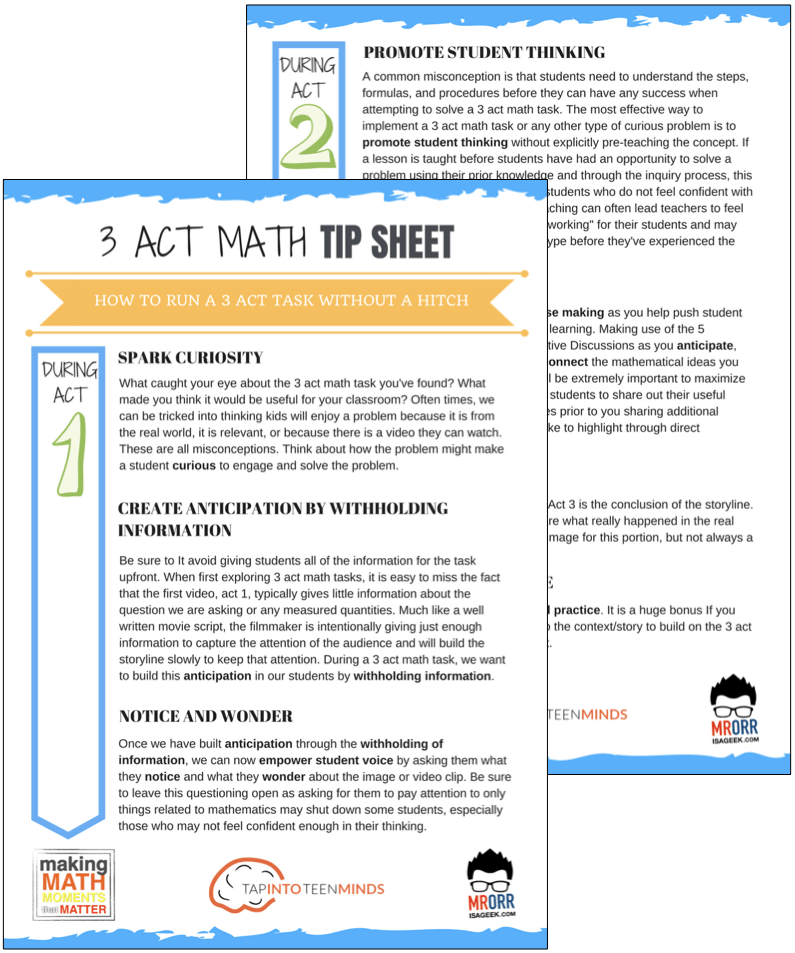
LESSONS TO MAKE MATH MOMENTS
Each lesson consists of:
Each Make Math Moments Problem Based Lesson consists of a Teacher Guide to lead you step-by-step through the planning process to ensure your lesson runs without a hitch!
Each Teacher Guide consists of:
- Intentionality of the lesson;
- A step-by-step walk through of each phase of the lesson;
- Visuals, animations, and videos unpacking big ideas, strategies, and models we intend to emerge during the lesson;
- Sample student approaches to assist in anticipating what your students might do;
- Resources and downloads including Keynote, Powerpoint, Media Files, and Teacher Guide printable PDF; and,
- Much more!
Each Make Math Moments Problem Based Lesson begins with a story, visual, video, or other method to Spark Curiosity through context.
Students will often Notice and Wonder before making an estimate to draw them in and invest in the problem.
After student voice has been heard and acknowledged, we will set students off on a Productive Struggle via a prompt related to the Spark context.
These prompts are given each lesson with the following conditions:
- No calculators are to be used; and,
- Students are to focus on how they can convince their math community that their solution is valid.
Students are left to engage in a productive struggle as the facilitator circulates to observe and engage in conversation as a means of assessing formatively.
The facilitator is instructed through the Teacher Guide on what specific strategies and models could be used to make connections and consolidate the learning from the lesson.
Often times, animations and walk through videos are provided in the Teacher Guide to assist with planning and delivering the consolidation.
A review image, video, or animation is provided as a conclusion to the task from the lesson.
While this might feel like a natural ending to the context students have been exploring, it is just the beginning as we look to leverage this context via extensions and additional lessons to dig deeper.
At the end of each lesson, consolidation prompts and/or extensions are crafted for students to purposefully practice and demonstrate their current understanding.
Facilitators are encouraged to collect these consolidation prompts as a means to engage in the assessment process and inform next moves for instruction.
In multi-day units of study, Math Talks are crafted to help build on the thinking from the previous day and build towards the next step in the developmental progression of the concept(s) we are exploring.
Each Math Talk is constructed as a string of related problems that build with intentionality to emerge specific big ideas, strategies, and mathematical models.
Make Math Moments Problem Based Lessons and Day 1 Teacher Guides are openly available for you to leverage and use with your students without becoming a Make Math Moments Academy Member.
Use our OPEN ACCESS multi-day problem based units!
Make Math Moments Problem Based Lessons and Day 1 Teacher Guides are openly available for you to leverage and use with your students without becoming a Make Math Moments Academy Member.
Partitive Division Resulting in a Fraction
Equivalence and Algebraic Substitution
Represent Categorical Data & Explore Mean
Downloadable resources including blackline masters, handouts, printable Tips Sheets, slide shows, and media files do require a Make Math Moments Academy Membership.
ONLINE WORKSHOP REGISTRATION

Pedagogically aligned for teachers of K through Grade 12 with content specific examples from Grades 3 through Grade 10.
In our self-paced, 12-week Online Workshop, you'll learn how to craft new and transform your current lessons to Spark Curiosity, Fuel Sense Making, and Ignite Your Teacher Moves to promote resilient problem solvers.
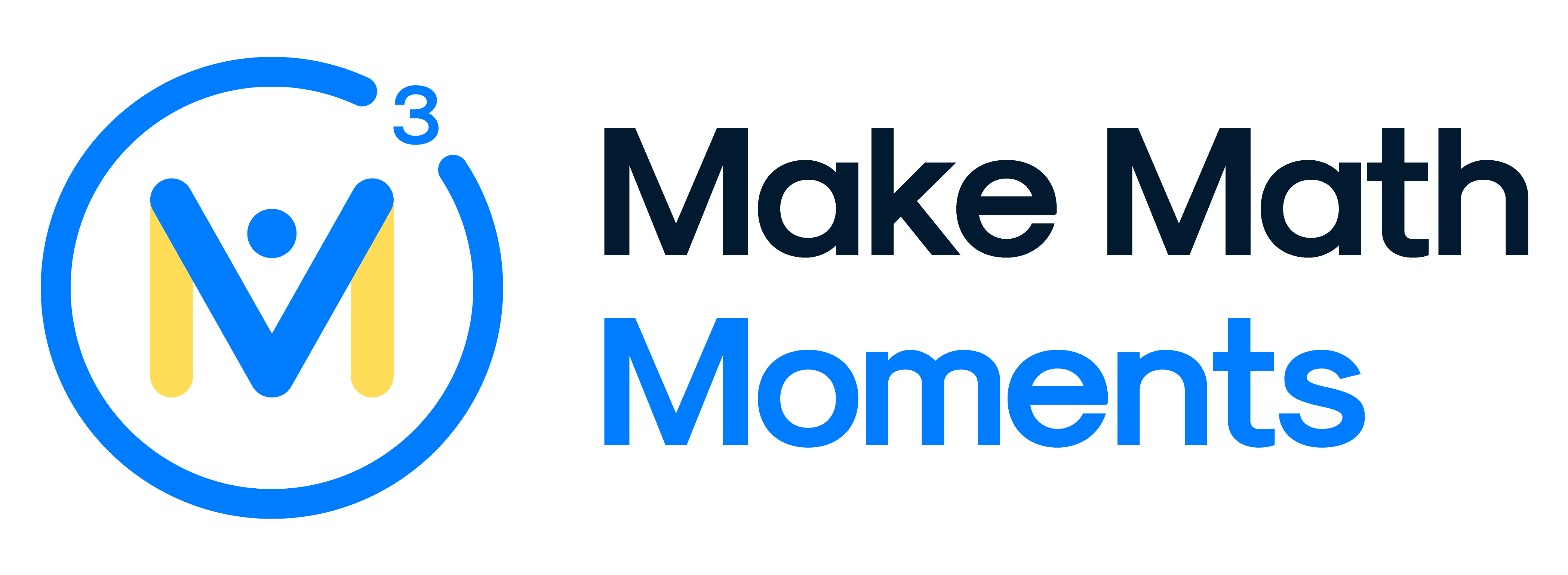



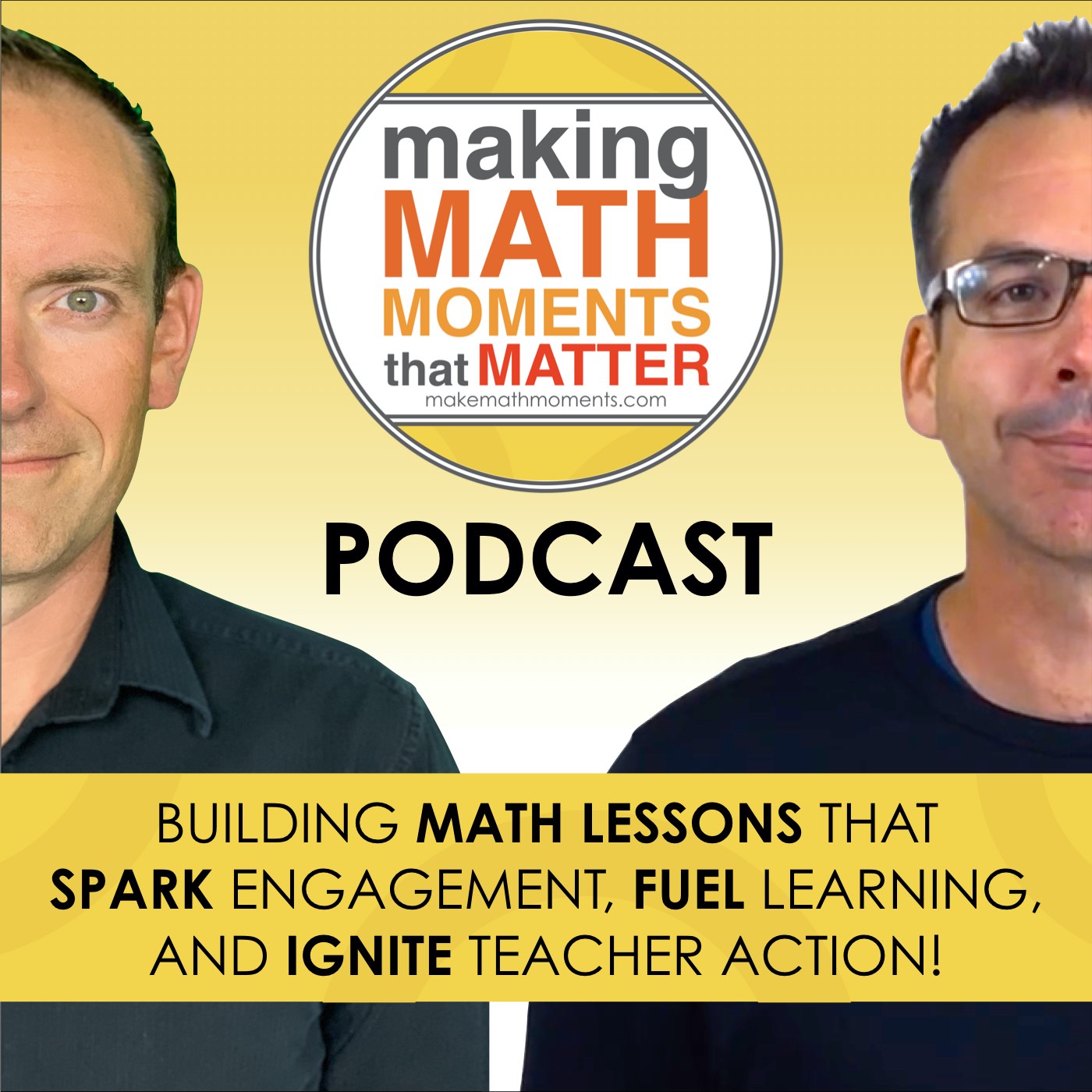
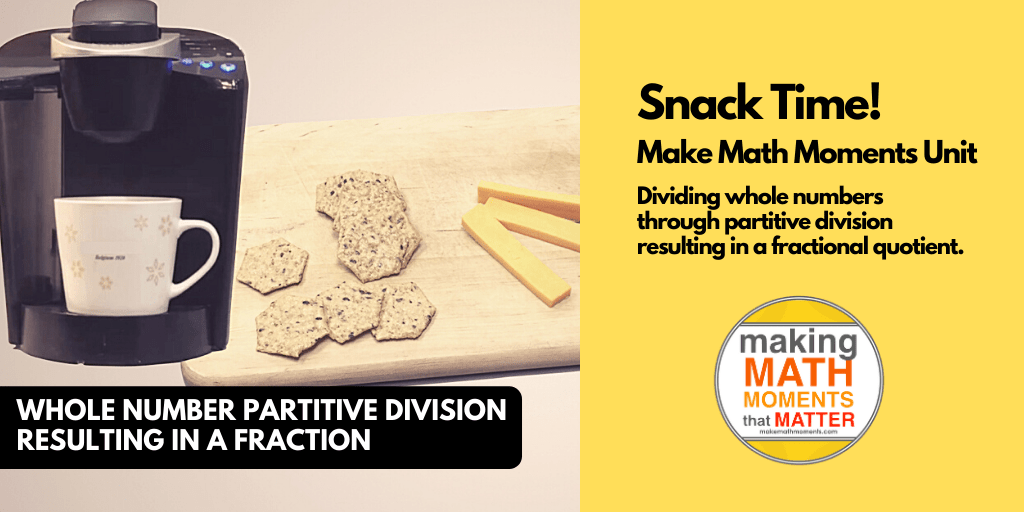
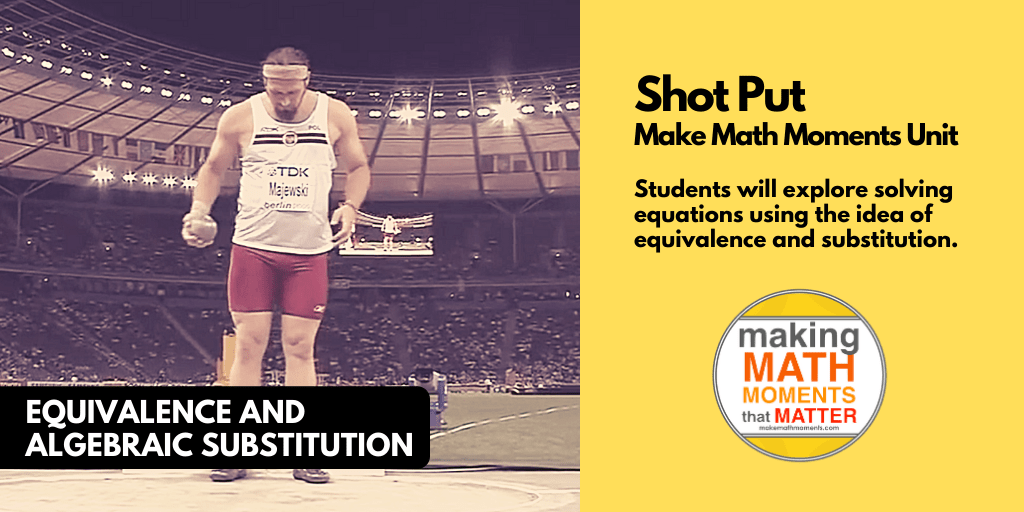
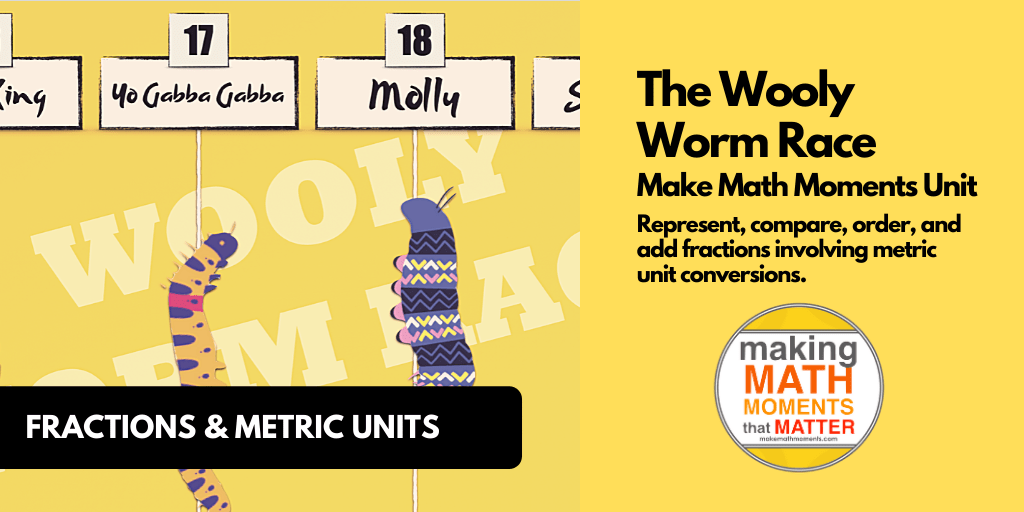

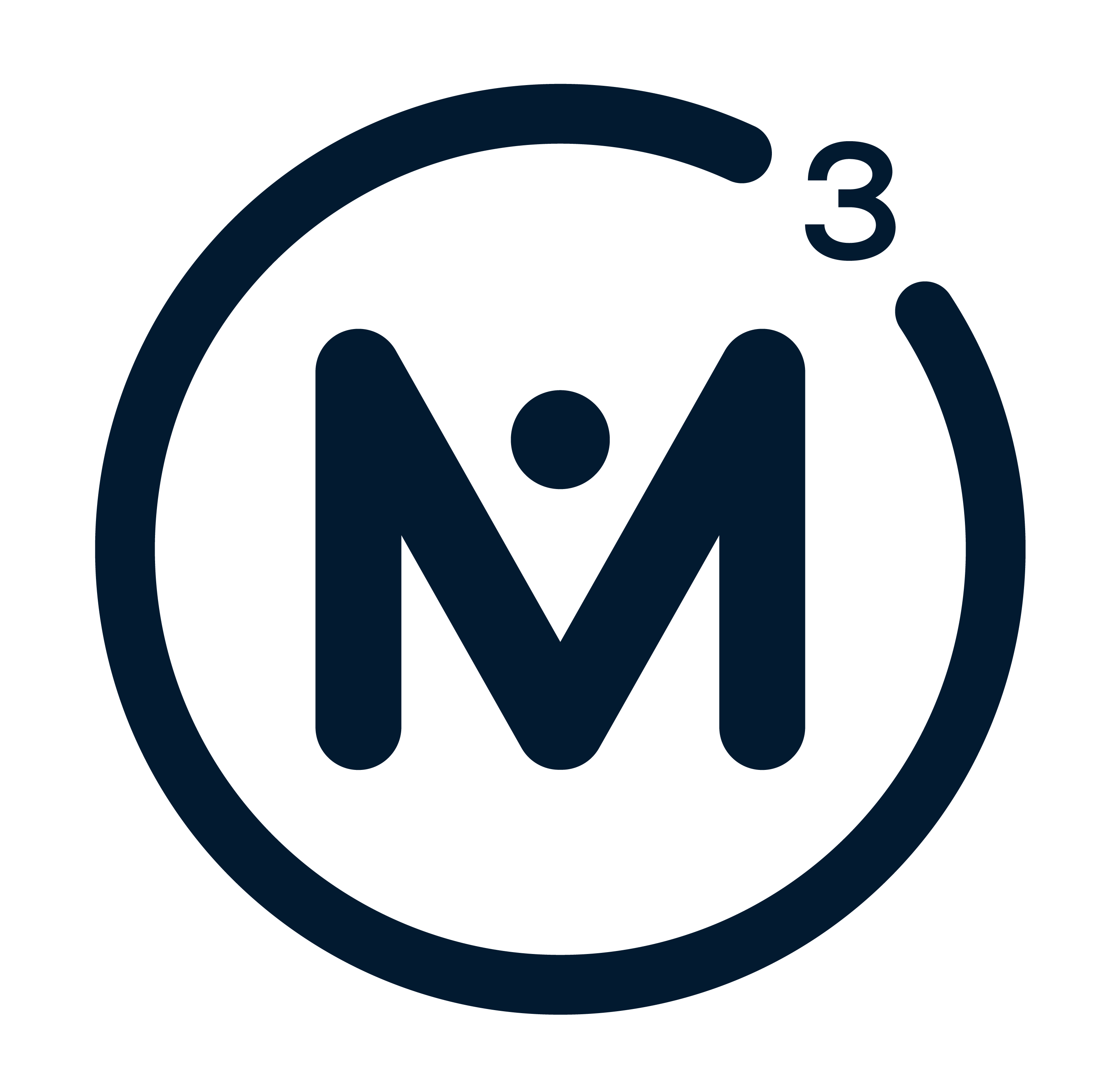
0 Comments